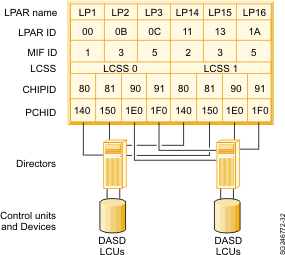A CHPID no longer directly corresponds to a hardware channel, and
CHPID numbers may be arbitrarily assigned. A hardware channel is now identified
by a physical channel identifier, or PCHID.
A z990 with multiple logical channel subsystems is shown in Figure 1,
which gives us an opportunity to go a little deeper into how the I/O subsystem
functions.
Two logical channel subsystems are defined (LCSS0 & LCSS1). Each LCSS
has three logical partitions with their associated MIF identifiers. An explanation
of MIF and the other features within Figure 1 follows.
Figure 1. Logical channel subsystem (LCSS) connectivity
- LPAR name (logical partition name)
This name is user-defined
through HCD or IOCP and is the partition name in the RESOURCE statement in
the configuration definitions.
The names must be unique across all logical
channel subsystems defined for the z990.
- LPAR id (logical partition identifier)
The logical partition
identifier is a number in the range from ‘00’ to ‘3F’. It is assigned by the
user on the image profile through the support element (SE) or the Hardware
Management Console (HMC).
Note: The logical partition
identifier is unique within the central processor complex.
|
- MIF ID (multiple image facility identifier)
The MIF number is
used to facilitate channel sharing among LPARs.
The MIF ID is a number
that is defined through Hardware Configuration Dialog (HCD). It is a number
that is specified in the RESOURCE statement in the configuration definitions.
It
is in the range ‘1’ to ‘F’ and is unique within a logical channel subsystem,
but it is not unique within the z990. Multiple logical channel subsystems
may specify the same MIF ID.
- CHPID (channel path identifier)
CHPID number is associated with
a physical channel port location (PCHID), and a logical channel subsystem.
The CHPID number range is still from ‘00’ to ‘FF’ and must be unique within
a logical channel subsystem.
- Control unit
The CU provides the logical capability necessary
to operate and control an I/O device, and it adapts the characteristics of
each I/O device to the standard form of control provided by the channel.
A
control unit may be housed separately, or it may be physically and logically
integrated with the I/O device. In Figure 1,
the control units have been logically divided into logical control units,
or LCUs.
- I/O device
I/O devices are used to provide external storage
(for example, disk storage called DASD or direct access storage devices),
to communicate between data processing systems, and to communicate between
a data processing system and the external world.
- Director
A director is an I/O interface providing multiple connectivity
capabilities between the channels on the mainframe and the control units of
the devices.
 Networking on z/OS
Networking on z/OS
 Networking on z/OS
Networking on z/OS
 Copyright IBM Corporation 1990, 2010
Copyright IBM Corporation 1990, 2010